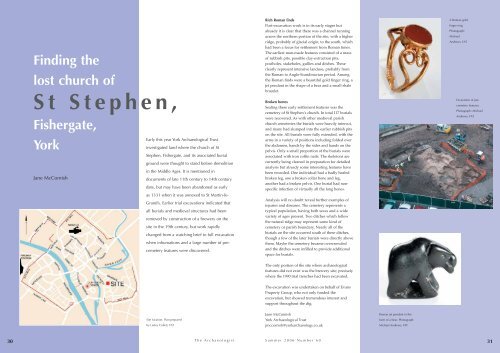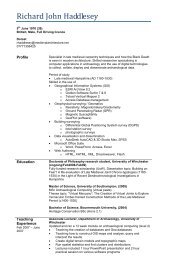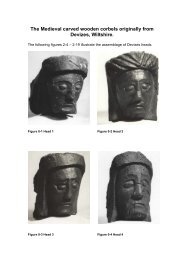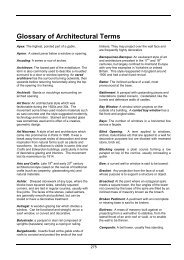The ARCHAEOLOGIST - English Late-Medieval timber-framed ...
The ARCHAEOLOGIST - English Late-Medieval timber-framed ...
The ARCHAEOLOGIST - English Late-Medieval timber-framed ...
You also want an ePaper? Increase the reach of your titles
YUMPU automatically turns print PDFs into web optimized ePapers that Google loves.
Finding the<br />
lost church of<br />
St Stephen,<br />
Fishergate,<br />
York<br />
Early this year York Archaeological Trust<br />
investigated land where the church of St<br />
Stephen, Fishergate, and its associated burial<br />
ground were thought to stand before demolition<br />
in the Middle Ages. It is mentioned in<br />
Jane McComish<br />
documents of late 11th century to 14th century<br />
date, but may have been abandoned as early<br />
as 1331 when it was annexed to St Martin-le-<br />
Grand’s. Earlier trial excavations indicated that<br />
all burials and medieval structures had been<br />
removed by construction of a brewery on the<br />
site in the 19th century, but work rapidly<br />
changed from a watching brief to full excavation<br />
when inhumations and a large number of precemetery<br />
features were discovered.<br />
Rich Roman finds<br />
Post-excavation work is in its early stages but<br />
already it is clear that there was a channel running<br />
across the northern portion of the site, with a higher<br />
ridge, probably of glacial origin, to the south, which<br />
had been a focus for settlement from Roman times.<br />
<strong>The</strong> earliest man-made features consisted of a mass<br />
of rubbish pits, possible clay-extraction pits,<br />
postholes, stakeholes, gullies and ditches. <strong>The</strong>se<br />
clearly represent intensive landuse, probably from<br />
the Roman to Anglo-Scandinavian period. Among<br />
the Roman finds were a beautiful gold finger ring, a<br />
jet pendant in the shape of a bear and a small shale<br />
bracelet.<br />
Broken bones<br />
Sealing these early settlement features was the<br />
cemetery of St Stephen’s church. In total 117 burials<br />
were recovered. As with other medieval parish<br />
church cemeteries the burials were heavily intercut,<br />
and many had slumped into the earlier rubbish pits<br />
on the site. All burials were fully extended, with the<br />
arms in a variety of positions including folded over<br />
the abdomen, hands by the sides and hands on the<br />
pelvis. Only a small proportion of the burials were<br />
associated with iron coffin nails. <strong>The</strong> skeletons are<br />
currently being cleaned in preparation for detailed<br />
analysis but already some interesting features have<br />
been recorded. One individual had a badly healed<br />
broken leg, one a broken collar bone and leg,<br />
another had a broken pelvis. One burial had nonspecific<br />
infection of virtually all the long bones.<br />
Analysis will no doubt reveal further examples of<br />
injuries and diseases. <strong>The</strong> cemetery represents a<br />
typical population, having both sexes and a wide<br />
variety of ages present. Two ditches which follow<br />
the natural ridge may represent some kind of<br />
cemetery or parish boundary. Nearly all of the<br />
burials on the site occurred south of these ditches,<br />
though a few of the later burials were directly above<br />
them. Maybe the cemetery became overcrowded<br />
and the ditches were infilled to provide additional<br />
space for burials.<br />
A Roman gold<br />
finger ring.<br />
Photograph:<br />
Michael<br />
Andrews, YAT<br />
Excavation of precemetery<br />
features.<br />
Photograph: Michael<br />
Andrews, YAT<br />
<strong>The</strong> only portion of the site where archaeological<br />
features did not exist was the brewery site; precisely<br />
where the 1990 trial trenches had been excavated.<br />
<strong>The</strong> excavation was undertaken on behalf of Evans<br />
Property Group, who not only funded the<br />
excavation, but showed tremendous interest and<br />
support throughout the dig.<br />
Site location. Plan prepared<br />
by Lesley Collett, YAT<br />
Jane McComish<br />
York Archaeological Trust<br />
jmccomish@yorkarchaeology.co.uk<br />
Roman jet pendant in the<br />
form of a bear. Photograph:<br />
Michael Andrews, YAT<br />
30<br />
<strong>The</strong> Archaeologist<br />
Summer 2006 Number 60<br />
31





